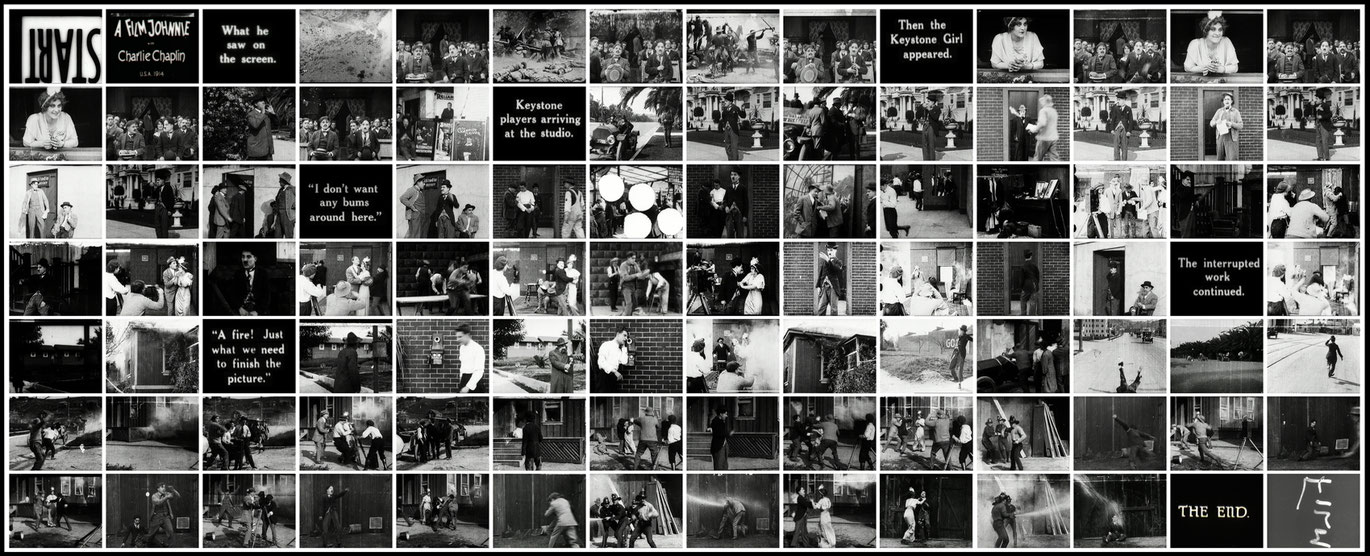MOSAIK MÉCANIQUE
For the artist Fernand Leger (1881-1955), the promise of film as a new art form lay in its potential to exhibit the visual, to present an image rather than tell a story. This attribute characteristic of early cinema, a "cinema of attractions" (Tom Gunning), has been directly associated with avant-garde film in terms of visual exhibitionism as well as the construction of an audience that is both directly addressed and activly engaged.
Norbert Pfaffenbichler takes this formal and historical connection as a point of departure for MOSAIK MÉCANIQUE - his title deriving from Leger´s sole experimental film, Ballet Mecanique (F 1924), and Peter Kubelka´s first film, Mosaik in Vertrauen (A 1955). An incomprehensible mass of teeming objects, movements, and performers is unfolded in CinemaScope. The screen is structured by a grid of 7 x 14 image apertures or windows which singlehandedly seem to keep the chaos in check and aspire to the possibility of a unity. A title vignette indicates that the source material is from the slapstick comedy, A Film Johnny (USA 1914), in which Charlie Chaplin continuously confuses the movie set with "reality". It is presented by 98 shots running in parallel loops. MOSAIK MÉCANIQUE thus dissolves the linearity of its analog source material. The film in its entirety, including head and tail leader, is digitally translated and thereby unspooled from the reel and broken open. Spatial structure replaces the temporal, synchronicity replaces chronology.
The audience is not only confronted with an unmediated visuality, it is torn back and forth between an analytic way of seeing rhythmic patterns or refracting motifs, and the impulse to (re)construct a plot. Picture and sound - Bernhard Lang composed an analog soundtrack in conjunction with the film loops - demand undivided attention.
The mosaic presented is a kaleidoscope or a crystal that short-circuits temporal and spatial dimensions as well as different media and their historicity.
(Claudia Slanar)
Translation: Eve Heller
All the shots of the slapstick comedy A Film Johnnie (USA 1914) are shown simultaneously in a symmetrical grid, one after the other. Each scene, from one cut to the next, from the first to the last frame, is looped. A pulsing visual polyrhythm is produced as a result of the shots’ varying lengths. The total length of the mosaic film corresponds precisely to that of the original.
(Norbert Pfaffenbichler)
--> go to artist´s homepage
MOSAIK MÈCANIQUE (fr.) de Claudia Slanar
C'est cette liaison, historique et formelle, que Norbert Pfaffenbichler prend comme point de départ dans MOSAIK MÈCANIQUE uvre qui tire son nom du seul film expérimental de Fernand Léger Ballet mécanique (F 1924) et du premier film de Peter Kubelka Mosaik im Vertrauen (A 1955) : sur l'écran au format cinémascope se déploie un incroyable foisonnement d'objets, de mouvements et d'acteurs. Seule la division de l'image en 7 x 14 cadres semble à même de contenir cette prolifération et de former finalement un tout. La vignette du générique définit le matériau présenté : la comédie burlesque Charlot fait du cinéma (A Film Johnnie, USA 1914), dans laquelle Charlie Chaplin confond en permanence plateau de cinéma et vie réelle, apparaît en 98 plans parallèles mis en boucle. MOSAIK MÈCANIQUE abolit ainsi la linéarité du cinéma, médium analogique : de par sa transposition au mode numérique, le film est entièrement déroulé et mis à plat (y compris l'amorce de tête et de fin). L'espace vient prendre la place de la structuration temporelle, la simultanéité celle de la chronologie. Dès lors, le public n'est plus seulement confronté à la visualité immédiate, il est également ballotté entre une approche analytique (il assiste à l'émergence de structures rythmiques et de motifs répétitifs) et une tentative de (re)constitution d'une action. L'image et le son (composé par Bernhard Lang en parallèle avec les plans en boucle) de MOSAIK MÈCANIQUE nécessitent une attention constante.
Cette mosaïque est un kaléidoscope, un cristal qui met en jonction les plans temporel et spatial, les différents médiums et leur historicité. (Claudia Slanar)
Traduction: Françoise Guiguet
Jury Argument for Honorable Mention, Leeds Film Festival 2008 (Award)
MOSAIK MÉCANIQUE
2007
Austria
9 min 30 sec

